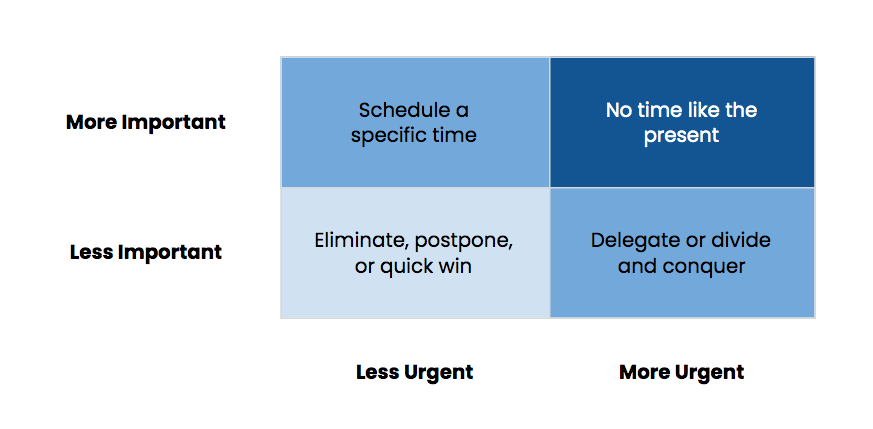
12 Aug Use This Simple Hack to Conquer Your To-Do List From Now On
The coronavirus pandemic has forced many of us into constant and relentless triage of tasks and assignments. It could be shifting to a remote work experience with our teams, struggling to retain and acquire customers, or ramping up to meet an explosion of demand. And this is only work. On the home front, we continue to navigate a myriad of challenges: trying to stay productive, caring for our loved ones, and doing our best to stay healthy. And now, just as we might be starting to find a rhythm, we need to layer on plans for some form of re-opening.
With all of this, it’s easy to feel overwhelmed, leaving us unsure of where to begin. In times of crises (as this is) it’s not uncommon for top-performing leaders to identify, isolate, and focus on two criteria – importance and urgency. Covey popularized a matrix using these criteria which can be adapted for current conditions. On one axis is importance, and on the other is urgency. When you need to prioritize your assignments, this matrix can help you decide when you can delegate, eliminate, or postpone the less essential in order to focus on what is mission-critical.
Learn to Prioritize
Start by writing out a comprehensive “to-do” list including the tasks that are the hot topic of every meeting to the ones that keep you up at night. Get them out of our head and onto some paper. If that’s too overwhelming, try organizing to-dos by different projects, teams, or circles such as work, home, kids. Next, take some time to define the two axes.
First, understand how you measure a task’s importance. This can include the probability of success, impact (outcome or leading indicators), competitive advantage, value alignment, cost, risk, or must-have versus nice-to-have. Then consider how you measure urgency, whether by defining time frames (e.g., this morning, by the end of the day, this week, this month) or consequences or benefits of completing or delaying tasks.
Finally, you’ll need to plot your tasks on the matrix. In the upper right-hand corner, you’ll place the tasks that are both important and urgent. These are the top priorities that are time-sensitive and critical. Rather than talking about doing them again and again, tackle them head-on. They might be critical customer issues, or supplier inventory deadlines or to-dos that were pushed out from the week before and are now both important and urgent.
Prioritizing When You’ve Got Too Many To-Dos
Use this simple but highly effective 2×2 matrix to help you make decisions.

The upper left corner is for tasks that are important, but less urgent. These are tasks that are key for you to reach your goals but don’t need to be done right away. To prevent them from falling off your radar, schedule a specific time with an absolute, outer deadline. Perhaps, you need to create a plan for strategic pivots on the horizon, set up post-launch customer interviews or check-in with a new hire. Often, if these items are ignored, they will change from simmering on the back-burner to boiling over.
The lower right corner is for urgent tasks that are less important. These tasks are not central to your goals and are often opportunities for empowerment and teamwork. You can accomplish these tasks by unblocking projects that will enable others to succeed, encouraging autonomy, or pairing up on a problem. These to-dos can often easily be tackled with the help of others.
Finally, the lower-left corner is for tasks that are both less important and less urgent. You’ll want to find ways to close these out quickly. Begin by eliminating outdated tasks. For the remaining tasks, determine if postponing is the right call by assessing the negative impact and reversibility of consequences. We can also explore if some tasks can be converted into a quick win by completing them with reduced effort.
Prioritizing is for teams, too
This important/urgent matrix can also be helpful when teams are lost and disorganized. Gather the team virtually or face to face and walk through the prompts for the different quadrants using Zoom whiteboards, or post-its and flip-charts.
If your “to-do” list still feels untenable, try taking another sweep and identify those tasks that are clearly within our circle of control and relish in that self-empowerment. For those that you can’t control but can influence, identify the tangible ways you can push these tasks forward. For to-dos, you can’t control and can’t influence, set them aside for now, and watch and wait for conditions to change.
Keep this matrix dynamic by revisiting and redoing it regularly as you accomplish your to-dos (printing it and having at my desk work best for me), new tasks emerge, and our context pivots. With this urgent/important matrix, you can invest your energy where it is needed most.
